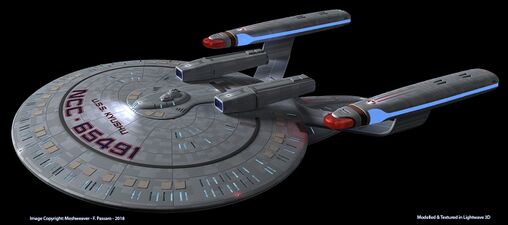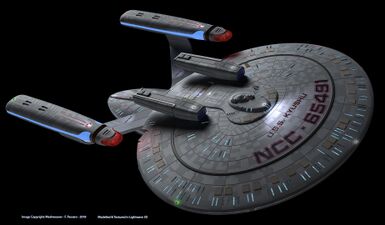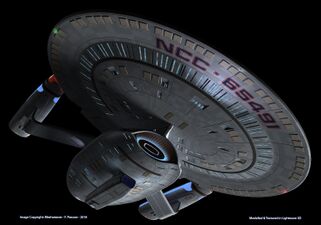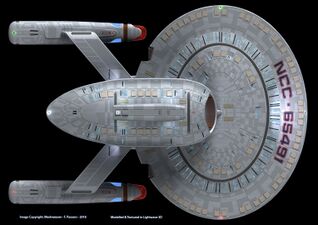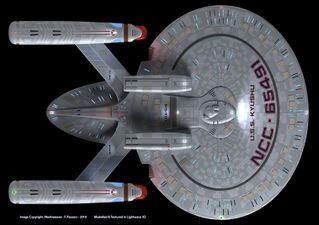Difference between revisions of "New Orleans Class"
CrimsonTacit (talk | contribs) (Images) |
(→Tactical: Experimenting with gallery options to try and show off these awesome New Orleans class images better. Broken into 2 packed galleries of 3 each to try and fit into the text width of the article. Packed gallery gives no frames. Set height to 150px to make them larger. Happy to revert, just seeing if it looks better.) |
||
| Line 73: | Line 73: | ||
The ''New Orleans''-class boasts impressive offensive and defensive systems for a ship of its size and age. It was designed to test two systems that would later become part of the ''Galaxy''-class design: type-X phaser arrays and burst-fire torpedo launchers. The Type-X phaser arrays were far superior to both the Type-IX arrays used aboard her cousins and to the now-dated Type-VIII banks found aboard the ''Miranda''-class, which the ''New Orleans'' was meant to supplant as a frigate. Like all classes built during the fleet modernization program of the 2340s and '50s, the ''New Orleans'' has two long phaser arrays on the primary hull, one ventral and one dorsal. There are also four additional arrays: one on the ventral side of each nacelle pylon and two on the ventral surface of the secondary hull, which provide all-around coverage. | The ''New Orleans''-class boasts impressive offensive and defensive systems for a ship of its size and age. It was designed to test two systems that would later become part of the ''Galaxy''-class design: type-X phaser arrays and burst-fire torpedo launchers. The Type-X phaser arrays were far superior to both the Type-IX arrays used aboard her cousins and to the now-dated Type-VIII banks found aboard the ''Miranda''-class, which the ''New Orleans'' was meant to supplant as a frigate. Like all classes built during the fleet modernization program of the 2340s and '50s, the ''New Orleans'' has two long phaser arrays on the primary hull, one ventral and one dorsal. There are also four additional arrays: one on the ventral side of each nacelle pylon and two on the ventral surface of the secondary hull, which provide all-around coverage. | ||
The burst-fire torpedo launchers are located in the "neck" of the ship above the navigational deflector and in the stern of the ship, and they are able to launch torpedoes in bursts of up to ten. These weapons, combined with the impressive sub-light maneuverability afforded by the ship’s impulse engines and the revolutionary sensor-pods, which allow for fast and accurate targeting and impressive stealth-detection capabilities, make the New Orleans class a very capable combatant. Tactical and Helm Officers are practically spoiled with the array of tools at their fingertips, but it takes a delicate and knowledgeable hand to know how to wield such weapons wisely and efficiently, especially given potential issues with the vessels’ EPS systems, should they be pushed too far.<gallery> | The burst-fire torpedo launchers are located in the "neck" of the ship above the navigational deflector and in the stern of the ship, and they are able to launch torpedoes in bursts of up to ten. These weapons, combined with the impressive sub-light maneuverability afforded by the ship’s impulse engines and the revolutionary sensor-pods, which allow for fast and accurate targeting and impressive stealth-detection capabilities, make the New Orleans class a very capable combatant. Tactical and Helm Officers are practically spoiled with the array of tools at their fingertips, but it takes a delicate and knowledgeable hand to know how to wield such weapons wisely and efficiently, especially given potential issues with the vessels’ EPS systems, should they be pushed too far. | ||
<gallery mode=packed heights=150px> | |||
File:NEW-ORLEANS1.jpg | File:NEW-ORLEANS1.jpg | ||
File:NEW-ORLEANS2.jpg | File:NEW-ORLEANS2.jpg | ||
File:NEW-ORLEANS3.jpg | File:NEW-ORLEANS3.jpg | ||
</gallery> | |||
<gallery mode=packed heights=150px> | |||
File:NEW-ORLEANS4.jpg | File:NEW-ORLEANS4.jpg | ||
File:NEW-ORLEANS6.jpg | File:NEW-ORLEANS6.jpg | ||
Revision as of 00:06, 26 February 2023
The New Orleans-class frigate is a very capable mid-sized starship developed in the 2340s and built up until the Battle of Wolf 359, when Starfleet's starship design ethos took a more militarized turn. They are no longer built, but remain in active service. One of four classes that served as testbeds for the Galaxy-class explorer and Nebula-class heavy cruiser, they are the most capable, most successful, and most numerous of the smaller cousins in this family. Specifically, the New Orleans was the prototype for the tactical systems in use by these larger ships.
Exploration and Science
Though classified as a frigate, the New Orleans-class is also a capable short-range explorer. Its three signature modular pods (typically seen deployed in the sensor-pod configuration) and state-of-the-art navigational deflector, coupled with its expanded computer core built specifically for processing huge amounts of data at a rapid pace, makes the New Orleans an incredibly reliable vessel for full and detailed long-range scans of undiscovered planets and interstellar phenomenon.
The relatively small secondary hull of the New Orleans leaves little room for spacious science facilities, especially when compared to its older cousin the Springfield-class science vessel or its younger cousins the Nebula and Galaxy-classes. This means that while the New Orleans is useful for long-range scientific surveys, data accumulation, and processing, it lacks the capacity for extensive on-board laboratory analysis of this data, which must be sent back home instead. The long-range scans conducted by New Orleans-class vessels have often laid the groundwork for additional scientific study, stellar cartography, and deep space exploration for future generations.
Such ventures into the unknown are also made possible by the ship’s revolutionary deflector design. Employing new navigational sensory technology and a distinctive eye-shaped deflector that would later become a signature of the Nebula and Galaxy-classes, helm officers aboard New Orleans vessels are free to set bolder courses with greater confidence in their ship’s ability to perform the necessary adjustments and calculations needed for long-range warp travel.
Operating a New Orleans-class vessel efficiently and effectively requires a particularly skilled Chief Science or Operations Officer, someone who can quickly pick out vital information from substantial sums of data and who knows what to look for when faced with otherwise bafflingly detailed readouts. However, such officers might find the on-board science facilities cramped and their access to resources somewhat limited compared to larger vessels they may have served aboard in the past.
Diplomacy
Though the saucer section of the ship is somewhat cramped and the observation lounge found at the saucer’s aft section is considerably smaller than those found aboard its larger contemporary vessels, the location itself still serves suitably as a highly adaptable conference room and relaxation area which allows the New Orleans to conduct limited diplomatic missions
Given the typical assignments of ships of this class, which commonly involve deployment to the edges of Federation space where they could come into contact with new life forms and with galactic powers, designating this space as a diplomatic amenity made sense without having to add a dedicated conference suite. That is not to say that Starfleet personnel aboard New Orleans vessels don’t also make ample use of the observation lounge for off-duty relaxation and casual meetings.
However, VIP quarters aboard ships of this class are few in number and not particularly spacious. That, along with the fact that these starships are typically deployed as tactical vessels in potentially hostile territory, makes the New Orleans a suboptimal candidate for diplomatic missions or ambassadorial functions when compared to other active vessel classes.
Engineering
Though considered a pioneering vessel in starship design during its hayday, the New Orleans does not come without its own engineering challenges with regards to keeping it afloat in space. It packs a lot of advanced systems into a relatively small frame. Its advanced sensor network and navigational controls, coupled with its large computer core and relatively heavy armament, can lead to certain strains and issues with EPS networking and power efficiency. Though the challenges have lessened as Starfleet has gained more experience with the class, it takes an exceptionally adaptable and sharp-minded engineering staff to keep a New Orleans running efficiently.
Despite this though, the navigational network made possible by the various sensor systems allows for cruising and max warp speeds of a comparable level to its contemporaries. The New Orleans-class also performs remarkably well at sublight speeds. Designed with more modern approaches to hull geometry, including incorporating an oval-shaped saucer section as opposed to the more traditional circular designs seen in decades prior, the vessel is remarkably agile and relatively easy to control at impulse speeds thanks to its wider triple impulse engine layout.
Easily the greatest adaptation for vessel design utilized by the New Orleans-class though is its set of triple modular pods. Though this class is most typically deployed with advanced sensor pods, additional phaser banks, cargo holds, or small craft facilities are also available. These adaptable pods, though rather resource-intensive when it comes to the vessel’s construction and maintenance because of the challenges they present to warp-field geometry and structural integrity field generation, allow the New Orleans an impressive level of adaptability and flexibility with regards to its varied assignments across Federation space.
Tactical
The New Orleans-class boasts impressive offensive and defensive systems for a ship of its size and age. It was designed to test two systems that would later become part of the Galaxy-class design: type-X phaser arrays and burst-fire torpedo launchers. The Type-X phaser arrays were far superior to both the Type-IX arrays used aboard her cousins and to the now-dated Type-VIII banks found aboard the Miranda-class, which the New Orleans was meant to supplant as a frigate. Like all classes built during the fleet modernization program of the 2340s and '50s, the New Orleans has two long phaser arrays on the primary hull, one ventral and one dorsal. There are also four additional arrays: one on the ventral side of each nacelle pylon and two on the ventral surface of the secondary hull, which provide all-around coverage.
The burst-fire torpedo launchers are located in the "neck" of the ship above the navigational deflector and in the stern of the ship, and they are able to launch torpedoes in bursts of up to ten. These weapons, combined with the impressive sub-light maneuverability afforded by the ship’s impulse engines and the revolutionary sensor-pods, which allow for fast and accurate targeting and impressive stealth-detection capabilities, make the New Orleans class a very capable combatant. Tactical and Helm Officers are practically spoiled with the array of tools at their fingertips, but it takes a delicate and knowledgeable hand to know how to wield such weapons wisely and efficiently, especially given potential issues with the vessels’ EPS systems, should they be pushed too far.
Shipboard Life
Though the New Orleansd does have holodecks and other recreation spaces like other vessels of her age, more of the ship's internal structure is devoted to weapons and power systems than her contemporaries. Officers who serve aboard a New Orleans-class might find these facilities lacking, compared to larger and more modern ships.
The saucer section of the New Orleans-class typically houses senior and commissioned officer quarters. The Captain and the First Officer’s quarters are of the same size and design as other senior officer quarters, though they do enjoy the privilege of a slightly larger viewport, which allows for a more scenic environment. Typically large enough for all basic needs, senior officers’ quarters have two separate rooms: A living area and a bedroom with an attached bathroom. These rooms are comparably spacious and allow for some personal flair and decoration, though officers transferring from Ambassador or Excelsior-class vessels might find them to be a tad smaller than they had hoped.
Junior commissioned officers typically share quarters, which usually consists of two separate bedrooms with attached bathrooms and a single shared living space, comparable to a single Senior Officers’ quarters. The secondary hull section contains enlisted and non-commissioned officer quarters, each of which has a single room featuring a bunk bed built into the bulkhead and a small living area with an attached bathroom. These quarters are infamously cramped, something many non-commissioned officers of higher rank claim to be effective for ‘character building’ and a rite of passage in Starfleet.
The mess hall aboard the New Orleans-class is of a reasonable size, all things considered, and is typically capable of seating about 50 or so people at once. Conversations in such mess halls could typically be likened to that of a large café, with officers breaking off into small groups to discuss the latest nightmares of engineering, or complaining to their friend that one of the senior officers is abusing the extra space of the cargo pod module to stow several cases of Arcanis Lager for their next shore leave. A common custom aboard one such New Orleans ship, the USS Al Khobar, was to push all the tables in the mess hall together after victory in battle and have a huge buffet where the crew were all brought together as one to celebrate.
The observation lounge, which could be reserved for the occasional dignitary, ambassador, delegate, or civilian, is also a relaxing place to spend one’s time aboard a New Orleans-class. Despite its small size (as with most facilities about the vessel), the rear-dorsal lounge serves as an effective meeting room for senior officers, a gathering location for briefings amongst departments, or a room that could host smaller diplomatic functions such as mediations between factions or trade negotiations.
Civilians aboard New Orleans vessels are usually rare, due to the lack of available space and amenities and the typically hostile and dangerous assignments the ships tend to be deployed to. This lack of a civilian influence and concern, coupled with the New Orleans’ smaller crew complement and tactical deployments, typically leads to a strong interpersonal connection amongst the whole crew and a deep and profound sense of loyalty to one another when under fire, either from the enemy or from Starfleet’s own admiralty. However, the New Orleans houses just enough officers for friendly competition or even some rivalries to grow either amongst individual crewmen, groups of people, or even whole starship departments. Whilst friendly competition is usually encouraged by senior officers, tensions and animosity between crew are quickly stamped out.
Class History
As part of the fleet modernization program throughout the 2340s, the New Orleans was designed to be the fourth and final of series of medium-sized vessels that would supplement and replace where possible the aging Miranda and Constellation-class cruisers. Though the specifications called for a vessel nearly the size of a Constitution-class vessel, the New Orleans was classified as a frigate and was meant to answer the growing tensions along the Cardassian Border. This vessel was chosen to prototype the Type-X phaser arrays that would become standard for the following forty years on Federation vessels and would be equipped with extensive long-range sensors for border surveillance.
It became apparent during the initial development phase of the New Orleans that the state-of-the-art sensor pods, though incredibly effective in their own right, would be an unnecessary tool for captains with regards to certain other missions. Therefore, the decision was made to make the pods a modular feature of the vessel, allowing them to be swapped out with relative ease during pre-mission refits for additional cargo holds, added firepower in the form of phaser banks, or even small hangar bays for small craft, essentially turning the New Orleans into a light carrier for certain missions.
Designing the New Orleans was a challenge for the Starfleet Corps of Engineers, and initial construction was difficult and costly on the Federation in terms of functionality and resources. The modular mission pod design, in particular, was difficult to perfect, and even Starfleet’s best struggled to find an efficient way to increase the vessels’ warp core power output to match the high demands of all of the vessels new and comparably taxing systems on the EPS grid, even with the support of auxiliary power from the impulse reactors.
Despite the initial struggles of the ship’s development though, its shakedown cruise proved to the Starfleet Admiralty just what it could do. Despite initial struggles with maintaining efficient power in all systems, the vessel’s incredible sensor capabilities and patented new phaser arrays lead to it becoming a first-class choice for a short-range explorer and frigate amongst the Federation’s border regions. In the early months of 2352, the USS New Orleans, the first commissioned vessel of its class, departed from the Utopia Planitia shipyards and headed for the borders of the Cardassian Union.
Though obviously the most capable of her other small cousins (the Springfield, Challenger, and Cheyenne), this class had a relatively limited production run largely due to factors beyond her control: first and most importantly, she was the last of the line designed before the more capable Nebula-class was introduced and Starfleet generally preferred ordering one of those in favor of three or four of the New Orleans and secondly, the Battle of Wolf 359 led to a dramatic reimagining of Federation shipbuilding and Starfleet’s defensive strategy, leading to the majority of New Orleans-class orders to be replaced with Akira-class orders in the late 2360s. Those that were commissioned however have remained in service for many years, becoming venerable ships of respect and renown across the Alpha and Beta Quadrants. The most famous of the New Orleans-class vessels launched was the USS Rutledge, which earned a reputation as a veteran of the Federation-Cardassian War of the 2350s.
The Starfleet Corps of Engineers made some incredible strides with their development of the New Orleans and many of the lessons learned from both its triumphs and its failures were employed in later ship designs, including those still being developed today.
Though the modular mission pods were incredibly effective, their resource-intensive design, both in terms of manufacturing and of powering the modules, was deemed an inefficient use of the vessels EPS headroom and the decision was made to instead employ a more singular multi-mission pod design in later designs such as the Nebula and Luna-classes.
The New Orleans In-Play
- One of the classes seen only on screen during the aftermath of the Battle of Wolf 359, the New Orleans is essentially a minaturized, combat-oriented Galaxy-class ship in appearance. It is the largest and most capable of the smaller vessels built at the same time as the Galaxy and Nebula, being much more capable than the Miranda as a frigate in combat situations. Of the four proto-Galaxies in service, it is the one you're most likely to encounter because it's the one that was best at its job and so the one that saw the largest orders.
- While certainly not an "escort" like the Defiant, the New Orleans is still a ship that can punch above its weight class. It can confidently engage in most combat situations, and as a border and frontier patrol ship, it's likely to encounter these scenarios.
- This would be a good command for a new captain, as they are numerous, modern, and provide an opportunity for a green skipper to learn the ropes.
- Contrary to popular fanon opinion, the three bulbous structures above and below the ship's hull are not torpedo launchers, but are modular pods. Most often, they are sensor pods. They could also be cargo pods. Use your imagination, here!
